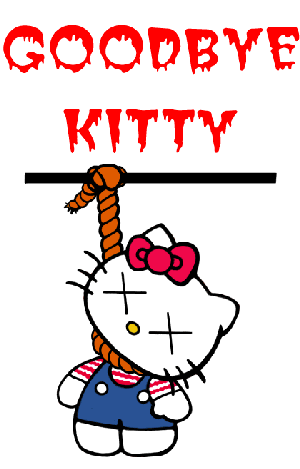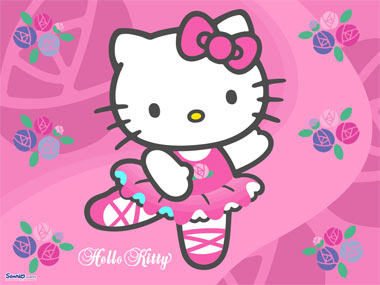 |
||||
|
Hello Kitty Hegemony
“What fucked up version of hello kitty are you?”
1 “Power often comes in deceptive packages” (Myers, 2002) 2 Hello Kitty is the ultimate icon of Japanese cuteness. She/it is simply the image of a cat with black eyes, a button nose and no mouth wearing a pink bow on her head. A product without context, Hello Kitty is a blank signifier with the potential to be loaded with codes and meanings as diverse as the ideas of those who consume her/it. Yet Hello Kitty encompasses, and holds contradictory associations with, discourses as diverse as debates over reappropriation of symbols, consumerism and nationalism. 3 As a symbol of cuteness, with her inability to communicate verbally and her pink bow, Hello Kitty has become a player in the wider debate on “girlie” culture and whether symbols traditionally (by feminists) held to play a part in the oppression of women, can now be used as tools of cultural subversion (Greer, 1999). 4 Riot grrrl was a movement which came to prominence in the early 1990s with all-female punk rock bands such as Bikini Kill, L7 and Babes in Toyland, and incorporated gender politics in to rock music, creating a new girl-focused subculture. The scene is still going strong now, although it receives less mainstream media attention (see Live Journal riot_grrls on-line community). It is often associated with the “girlie” look and many current riot grrrls consider themselves third-wave feminists. 5 Girlie culture and riot grrrl are not to be confused with the girl power propagated by pop music, which is seen to be “insipid spice girl shit” (Riot Grrrl London) by riot grrrl feminists. A common mistake of older feminist’s criticisms is to equate mainstream “girl power” with the sub-cultural movement of riot grrrl, incorporating within it girlie feminism (See for examples the chapter on Girl power in Greer, 1999).
Girlie Feminism: Separate But Equal 6 Within the riot grrrl movement there has been a reappropriation of girliness as demonstrated by the use of “grrrl” as opposed to “girl”, severing its connotations of weakness and femininity and, thus, transforming its meaning. Hello Kitty and the debate around her/its consumption by riot grrrls can been used to examine the debates, contradictions, criticisms, reappropriations and ironies which are central to third-wave feminisms. 7 One more sympathetic reading of the current “girlie” culture and its use of Hello Kitty as a logo assumes that it is highly ironic and that the girls involved have all the cultural savvy natural to the third-wave generation who have been raised in a pop culture driven world. From this point of view, young women/girls are naturally wielding signifiers like semiotics professors in their everyday lives. For example see the on-line “What fucked version of hello kittie are you?” Quiz (Sarcasticwhore, 2003) which uses Hello Kitty as a blank signifier that can represent many different types of subcultural image (interestingly the username of the creator of this quiz, “sarcasticwhore” is itself reappropriation of the word “whore”). 8 hello there, kitty 9 Certainly there are some self-professed third-wave riot grrrls who are aware of the meanings of their actions: like the hello kitty pink fluffy thing - on the one hand if you're 'grown up' it can be a way of going against what's expected of you - to be respectable, orderly, lookin like you stepped out of Gap. on another hand it's a way of 'reclaiming yr femininity' which i am dubious about . . . . i feel that wearing particular things to convey an idea such as in this case reinforces the whole girl = one thing boy = another. But i totally agree, whole - heartedly, that women shouldn't bow down to the way of the man and attempt to be/look like them (i.e. deny their 'femininity' or wear suits and attempt to charge around blowing up the world like george bush) (Sabotage, 2003) 10 My research with the riot grrrl Birmingham collective suggests that many of the girls involved understand the political implications of their behaviour and that their aim is not assimilation in to the “male” identity but a “separate but equal” identity wherein femaleness does not equate to weakness. Riot Grrrl foremother Kathleen Hanna explains that the original philosophy of riot grrrl had the same basic principles as those expressed by Sabotage above: dressing like a little girl . . . was also about being people who are oppositional to the whole American system, and not wanting to look like adults and our parents, who we saw as fucking up the world. And it was also when that Carol Gilligan book came out about how girls lose their self-esteem around twelve or thirteen, so everyone was talking about being nine. Like trying to go back there, and remembering what it was like when we were friends with each other, and we weren't totally competitive, and we were creating our own weird games and ideas. (Hanna in Hex, 2000) 11 As Hanna pointed out, psychological research which focused on the negative effects of adolescence on girls showed that “the secrets of the female adolescent pertain to the silencing of her own voice, a silencing enforced by the wish not to hurt others but also by the fear that, in speaking, her voice will not be heard” (Gilligan, 1982, 51). This lead to a return to, and positivisation of, girlhood, a “nod to our joyous youth” (Baumgardner & Richards, 2001, 136) and a rejection of hegemonic ways of adult female behaviour. In relation to this psychological context, the mouth-less Hello Kitty takes on even more interesting connotations as a logo for third-wave riot grrrl feminism, as a logo which could also be seen to represent the voicelessness of girls, a logo re-contextualised by parody. Criticisms: Irony and Context 12 Linda Hutcheon, a postmodern / feminist theorist, sees parody and irony as defining features of postmodernism and feminisms in the age of post modernism: It seems to me that . . . women are often in the position of defining themselves AGAINST a dominant culture or discourse. One way to do that, a way with great subversive potential, is to speak the language of the dominant (which allows you to be heard), but then to subvert it through ironic strategies of exaggeration, understatement, or literalization (1998). 13 The main criticism of reappropriating symbols of oppression is the question of who creates the meaning and whether it is redundant if misinterpreted by the majority of people who see it. Moreover does postmodernism in relation to feminism suggest an acceptance of post-feminism or even an acceptance that ideas of girliness are no longer symbols of patriarchal oppression? The wearers may not think so, but the majority of “readers” may be oblivious to the complex connotations of a Hello Kitty t-shirt. Thus, the issue of context creates some problems for the effective use of girliness and, specifically, for Hello Kitty as a subversive tool, “The test of irony is that people get the joke – and if they had enough understanding to ‘get it’ in the first place, then this type of humour wouldn’t need to exist” (Direct Action 23, 2002). 14 In response to criticism that the ironic “girlie” use of Hello Kitty may be misinterpreted, I suggest juxtaposition of signifiers in order to upset hegemonic readings in a similar way to that suggested by Paul Sweetham (1990). That is, it seems more effective to confuse the signified of the reader by taking elements of, for example Hello Kitty with its connotations of girliness, and simultaneously incorporate signs of punk imagery. This serves to create a look which cannot be read as merely girly or as merely punk, which changes the function of both signifiers. Consumerism 15 Another element of the use of Hello Kitty as a logo for third-wave riot grrrl feminists is that Hello Kitty is the ultimate symbol of pure irrational consumerism and commodity fetishism, a “trap of material slavery” (Ko, 2000, 9). The uniqueness of Hello Kitty as a commodity is that the logo is the product; there is no (or at least was not originally) any story or context. This is especially problematic for Hello Kitty as a logo for Riot Grrrl, as this is a culture which sets itself apart from, and as a critique of, mainstream culture. This does not necessarily entail, however, a complete rejection of material culture and could simply mean an alternate or subverted form of it.
|
|
|||
|
|
||||

Conclusion 16 Despite its flaws, Hello Kitty can be seen to effectively, semeiologically speaking, represent a subculture inextricably set within and created from a pop-culture driven society. And while this use of Hello Kitty is entirely reliant on its context, in the context I have suggested it seems to effectively symbolise the ideologies of third-wave riot grrrls.
Works Cited
|
||||
 |
|
 |
||
